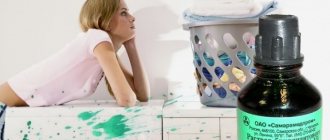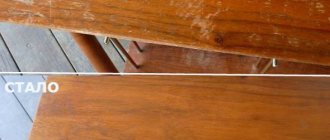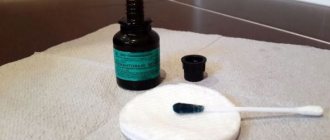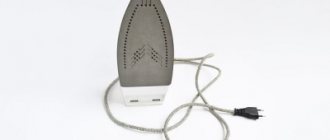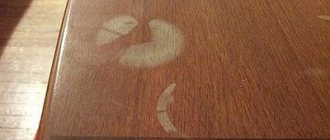How to remove blood from sheets and underwear is a sensitive and pressing question for every girl and woman. Any of us sooner or later encounters pollution during menstrual periods. Getting rid of menstrual marks is more difficult than getting rid of similar ones after cuts and wounds. After all, this is not just blood, but a mixture of enzymes, mucus and secretions, which is why it does not clot.
How to clean upholstery
How to wash off blood if the upholstery on the sofa is dirty? This is difficult to do because in most cases the upholstery cannot be removed. The stain will have to be wiped over and over again with a cleaning solution and blotted with a dry towel or napkin. Things to consider:
- you cannot clean the upholstery against lint;
- the cleaning agent is first applied to the sponge and then to the contaminated area;
- Before use, any composition should be tested on an inconspicuous area of the upholstery;
- Do not use too hot water, otherwise the blood will penetrate into the tissue even more.
The easiest way to get rid of scarlet marks is with hydrogen peroxide. To clean a sofa or chair, simply moisten a cotton swab with the solution and carefully begin to treat the stain. To prevent it from spreading and increasing in size, this must be done in the direction from the edges to the center. After 5-10 minutes, blot the treated area with a dry towel and repeat the operation again.
Washing sheets with dried blood
Often blood is discovered late, for example, a sheet is stained at night during menstruation. By morning it dries and eats into the fabric structure. If this happens, you should soak the item in cold water for several hours. The modern detergent market offers a large selection of softening options. Folk tips for removing blood recommend adding 3-4 crushed aspirin tablets or 1 teaspoon of citric acid to water.
After the fibers and stain have softened, a stain remover is applied. The above methods are good for blood stains that are not too dry.
For completely dried contaminants, the exposure time is 1.5-2 times longer. Also remember that it is necessary to repeat the cleaning procedure 2-3 times. Old stains are removed by rubbing with a brush. For this purpose, use an old toothbrush.
How to clean a carpet
Bloody marks are difficult to remove from carpet due to the fleecy surface. In addition, often the carpet has a variegated color, against which it is not immediately possible to see the burgundy drops.
It's easier to remove blood from carpet before it has time to dry.
Here are two options for carpet cleaning.
- Aspirin. To make a cleaning solution, drop an aspirin tablet into a soda and stir thoroughly. Saturate the contaminated area with the resulting mixture, and after twenty minutes, thoroughly wipe the area with a hard sponge. Then wash off any remaining dirt and dry the carpet with a hairdryer.
Making a cleaning solution from aspirin and sparkling water - Laundry soap. A good remedy if the burgundy drops on the carpet are fresh. Wipe the stained area with a well-soaped hard sponge. The foam should cover the entire stain for 5-10 minutes, after which the residue is simply washed off.
Laundry soap foam will help deal with fresh stains
You can also make a solution of 0.5 liters of cold water and 1 tbsp. l ammonia to remove stains from the carpet
If the above methods do not work, use store-bought stain removers or go to a dry cleaner.
How to remove fresh blood stains
If you have a blood stain on your clothing, immediately wash it with cold water.
Important! Never try to remove blood with hot water.
This approach will make the situation worse. Below are the most popular methods for removing stains at home in full detail.
Hydrogen peroxide
- After soaking with cold water, pour hydrogen peroxide or chlorhexidine into the dirt. Be careful not to allow any liquid to come into contact with the clean surface, as this may cause the fabric to fade.
- Wait 25-30 minutes.
- Blot the area to be treated with a paper towel or clean, white rag.
- The stain should become lighter or disappear. For complete removal, wash the entire product in the washing machine or by hand as you usually do.
IMPORTANT: Hydrogen peroxide can be replaced with table vinegar or sparkling water.
Ammonia
How to wash blood from a sheet is a pressing question for many girls during menstruation. Fresh blood stains can be easily removed with ammonia.
Articles on the topic (click to view)
- How to become a great lawyer?
- All the pros and cons of forged beds in the interior
- 29 years - Velvet wedding: description, meaning, options for celebration and gifts
- Why are solid doors better?
- Features of pool paths
- Green kitchen interior
- Fences for parking lots and parking areas
Ammonia is too caustic, so it is not recommended to use it in its pure form - it must be diluted.
One convenient option is glass cleaner. It contains ammonia, as well as fragrances that help quickly remove old dirt. To do this, wet the cloth with cold water, then spray the spray on the problem area. Leave for 15 minutes. When it becomes paler, wash it with laundry soap.
If the fresh blood stain is too large, you can use diluted ammonia. To do this, dilute 30 ml of liquid in 220 ml of distilled water. Use a spray bottle to apply. This way the product will be distributed evenly. After 40-50 minutes, blot the area with a clean rag and wash the clothes in cold water.
IMPORTANT: Ammonia will corrode colored fabric, destroying the paint.
Baking soda
A paste is prepared from baking soda and water, which is carefully applied with a toothbrush to a fresh stain.
Then iron the area with a white cotton cloth and leave it to dry in the open air.
Baby powder and corn starch are used in a similar way.
Salt
Salt, combined with the harsh environment of liquid soap or dishwashing detergent, does an excellent job of removing fresh blood on clothes. Leave the mixture on for 30 minutes and then simply rinse with cold water.
Natural stain remover
Supporters of environmentally friendly products will really like this method. A simple, gentle stain remover is made from:
- 30 g baking soda;
- 30 g chlorhexidine;
- 15 g cold water.
The mixture is shaken, then applied in an even layer. Exposure to the mixture is allowed for no more than 10 minutes, then it is washed off. If the stain does not disappear, repeat the procedure 2-3 more times.
Instead of soda, you can use citric acid. This solution removes stains from cotton.
Bleach, commercial stain remover
Purchased products for removing even fresh stains must be used correctly. First, pour a little stain remover onto the stained area and leave for 30 minutes. Then scrub and rinse with cold water. Refill and rinse the entire item thoroughly.
IMPORTANT: Laundry should dry naturally, without using batteries or strong hot air.
Old, dried out
Traces of blood that have already dried will be much more difficult to remove. If the recipe you are using does not help, you can use another one.
It is advisable to start processing by soaking the entire item in cold water. This technique will prepare the fabric for further processing.
If, after soaping with Antipyatin or laundry soap, the stain does not go away completely, proceed to removing the marks using one of the recipes.
Dishwashing gel
Shampoo or dish soap can be used to remove stains if nothing else is available and the stain is not yet old.
To do this, moisten the material, apply the selected preparation and rub gently. After 10 minutes, wash and rinse the item.
Another way is to apply undiluted dishwashing gel directly to the stained area of the material. Apply liberally, not in a thin layer.
After this, cling film is placed on top and left in this form for a couple of hours or even more, up to five. After this, the product is washed.
Hydrogen peroxide
White items can be treated with hydrogen peroxide, but only if the material is natural (cotton, linen) and dense.
Stain removal procedure:
- Use a bottle of peroxide to pour over the stain. Or treat it using a sponge.
- Allow time for the chemical reaction to take place.
- Wash the item.
This method is only suitable for fairly dense fabrics and is not recommended for delicate ones.
To remove a stain, you need to prepare a solution:
- pour 3 liters of cold water into a basin;
- add 60 grams of salt;
- stir;
- dip soiled clothes;
- leave for 6-8 hours;
- wash with Antipyatin or laundry soap;
- rinse.
For delicate fabrics, the option with salt is undesirable.
Removing stains with soda is carried out according to the following method:
- Pour 1 glass of cold water into a container.
- Pour 10-15 grams of soda into it.
- Stir.
- Pour the solution onto the mark.
- Leave for 30 minutes.
- Rub the dirty area.
- Wash the item using detergent.
The recipe is designed for thick fabric.
Ammonia
Ammonia allows you to remove blood from clothes, sheets and other soiled items made from linen or cotton.
Procedure:
- pour 3 liters of water into a basin;
- pour in 60 ml. ammonia;
- soak the thing;
- keep in the solution for a couple of hours.
Potato starch
For thick cotton and linen fabrics, you can use almost any of the recipes, but for delicate items you need to proceed differently:
- Pour ½ cup of starch into a container.
- Add a little water to form a paste.
- Apply the mixture to the fabric.
- Set the item aside for the time necessary for the paste to dry completely.
- Clean any remaining slurry from the material with a dry cloth or towel.
- Wash the product.
Vinegar
Table vinegar, thanks to the acid it contains, can be a good stain remover. A local stain can be treated with undiluted liquid and left for half an hour.
If there are several stains in different places, it would be better to prepare a solution of two parts water and one part vinegar. The item is completely dipped into it and left for 10-15 minutes, after which it is washed.
For vinegar to be 100% effective and completely remove stains, it should be used within the first 24 hours after the mark is formed. After this period, acetic acid will be less effective.
Glycerol
Glycerin is often used to remove stains. For the best effect of the manipulation, the bottle with glycerin should be warmed up a little so that it becomes warm.
Lemon and salt
Lemon juice is a natural product that helps in removing a variety of stains. Citric acid, like acetic acid, can also cope with blood stains.
For cleaning, prepare the following mixture:
- in a container mix 2 tbsp. l. lemon juice and 1 tbsp. l. salt;
- Using an old toothbrush, treat the fabric;
- Rinse the material with cold water.
The disadvantage of this method is its relatively low effectiveness against large or old stains. And the impossibility of using on colored fabrics.
Recommendations
Simple methods will help you remove blood stains from clothes. In addition to using recipes, you should follow these tips:
- When removing blood stains, you should wear rubber gloves to protect your hands from exposure to chemicals.
- If time was lost, the stain dried out, and then it was also processed incorrectly, the blood protein coagulates. It will be extremely difficult to remove such contamination.
As a last resort, if all resources have been exhausted, use intensive machine washing. However, the result is not guaranteed.
- Even for white fabrics, you should not be too zealous with the use of stain removers, since they not only have bleaching properties, but also thin the material itself.
- Preparations with chlorine worsen the condition of the tissue and have an insidious quality - they leave the outline of the stain visible after removing it.
- Industrial stain removers have different instructions, so be sure to read them.
You will find maximum useful information about washing clothes and various fabric products here.
Features of removal from various tissues
Removing traces of corrosion from fabric must be carried out not only taking into account the degree of contamination, but also taking into account the quality and color of the material. In order not to damage the structure of the fibers and maintain the shade, you should choose the right cleaner:
Black fabrics
The presence of dark pigment requires careful use of potent agents. Such things are treated with glycerin compounds, toothpaste, diluted vinegar
The use of bleach and strong acids is unacceptable.
Colored products. Clothing with a pattern belongs to the “complex” group. Many bleaches can worsen the color, so choose only those products that are gentle. Recipes with vinegar, glycerin, and toothpaste are suitable for colored ones. Colored items should not be left in the sun and treated with whiteness.
White linen. If the light-colored fabric is of natural origin (cotton, linen, viscose), then chlorine-containing or acid bleaches can be used to clean it. Citric and oxalic acids are allowed as home remedies.
Jeans. The thick fabric from which jeans are made is difficult to clean. To remove rust marks, use products with good penetrating ability. Vinegar, citric acid, and household chemicals are suitable.
Synthetics. Thin fabrics made from artificial fibers are sensitive to strong reagents. It is recommended to clean them using universal liquids or mixtures based on glycerin, vinegar, and citric acid.
Cotton, linen. Natural fabrics withstand organic acids (citric, oxalic, acetic). Household chemicals intended for these fabrics are also suitable.
Silk, satin. Delicate tissues do not tolerate aggressive substances and strong mechanical stress in the form of friction. To clean them, neutral, mild-acting compounds are used.
Delicate fabrics are especially sensitive to many chemicals, so it is better to take an expensive item to the dry cleaner.
Prohibitions and restrictions
There are many ways to remove stains, allowing you to choose the most suitable one. It must be taken into account that deviations from time-tested methods may not only not help, but also have the opposite effect.
The prohibitions include the following:
- Do not use hot water to remove stains. This is due to a protein that is part of the blood, which has the property of coagulating under the influence of high temperatures. In this case, the blood is retained and not removed.
- Do not rub a fresh stain so as not to smear it even more. Better to just get wet.
- If you don’t have time to soak and wash, you can apply the stain remover to the stained area, and after 10-15 minutes send the item to be washed in the machine. In this case, it is necessary to ensure that the water temperature is below +30ºС.
- If the fabric is delicate, then vinegar and ammonia should not be used without first testing on an inconspicuous area.
- Solvents such as acetone or white spirit should not be used.
How to remove blood from a sheet in a washing machine
The modern world surrounds people with devices that make life much easier. Unfortunately, thoughtlessly used stain removal mode of the washing machine will not be able to remove blood from the sheets.
Before throwing the sheet into the washing machine, apply stain remover to the stained area. It is best to use a spray. After 20-30 minutes, scrub the area. If the stain has faded, feel free to apply the bleach or stain remover again, and then put the sheet in the drum.
The mode is always selected 30-40°C, with spinning, but without drying. The higher the wash temperature, the more likely it is that blood will be absorbed more. It is very difficult to remove stubborn stains.
Removing blood from a terry sheet should be considered separately. Terry has a natural cotton composition and an original looped structure. Dirt particles cling to fabric loops, therefore, they cannot be removed without first soaking.
IMPORTANT: If the sheet removed from the drum is still dirty, apply the paste and soda to the surface again. Place a white cloth on top and iron with a lukewarm iron. The blood will remain on the rag.
Review of household chemicals for removing old stains
In addition to available products, you can wash at home with powders and stain removers designed specifically to combat various dried stains (traces of blood, oil). When purchasing, pay attention to the composition, the label, which indicates which fabrics the composition is suitable for. Among the popular ones are:
- Vanish Oxi Action;
- Amway PreWash;
- Sarma Active;
- Frau Schmidt;
- Edelstar.
Some chemicals come in the form of a spray, stick, or soap that is applied to the dried blood stain immediately before washing. After processing, the item must be washed in the usual way.
Carefully read the instructions on the packaging; ignoring the requirements will lead to poor results and damage to the appearance of the product.
https://www.youtube.com/watch?v=zyoKmo2GQv0
Rules for removing old traces of blood
The special composition of blood makes it difficult to remove traces of it from tissue. By reacting with oxygen, the protein is eaten into the fibers, and iron has strong coloring properties and leaves its mark throughout the entire thickness of the material. Over time, the protein coagulates and the contaminant becomes firmly attached to the fibers of the fabric. Therefore, simple washing with conventional detergents does not bring satisfactory results. Only the surface layer of the stain is washed off, and the main contamination in the thickness of the material remains in place.
Important! Even old bloody marks should not be poured with hot water. It will cause the protein to coagulate and the contamination will become impossible to remove.
When removing old traces of blood, follow the rules:
- use cool water, since hot water only fixes the mark more firmly in the fabric, and ice water brings a positive result only for fresh contamination;
- do not iron the item until the bloody trace is removed; high temperature leads to the coagulation of the protein;
- aggressive stain removers are first used on an inconspicuous area to test their effect on the fabric structure;
- After removing the blood, the item is rinsed in cool water to restore the brightness of the shades.
What not to do
To remove dried bloody marks at home, you should remember tips that will help preserve the product. Prohibited:
- Wash in hot water. High temperatures cause coagulation and rapid penetration deep into tissues. As a result, the item does not wash well and leaves a yellow mark.
- Do not rub over fresh stains. Mechanical effects with a brush or napkin rub blood into the material, saturate it, and make the mark dry. To remove moisture, blot with a dry napkin or cloth, then proceed to wash, following the recommendations.
- Choose the right product to remove dried blood stains. Some substances can damage the material, leaving the clothing unsuitable for further use.
By following simple tips, you can remove even dried blood stains without worrying about the appearance of the product.
The article has been verified by the editors
What not to do
When dealing with scarlet marks, it is not recommended to:
- Use hot water. Under its influence, the blood will only penetrate deeper into the fibers, so prohibiting the use of boiling water is one of the important conditions for success.
- Use a stiff brush. It will rub the stain and make it even wider.
- Wash immediately. This type of stain requires a long preliminary soaking. During the process, water saturates the fibers of the fabric and prevents blood particles from settling between the threads.
- Store dirty laundry for a long time. The further you delay the washing process, the less chance you have of saving your items.
- Immediately use folk remedies. The market is full of stain removers that are much more effective and convenient than available products.
We hope that the materials from our article helped you solve the problem of how to remove old blood stains and remove the slightest reminder of them. But if all of the above methods do not bring the expected effect, do not rush to give up and say goodbye to your clothes. Even such a problem can be solved simply and creatively: decorate the place with embroidery, appliqués or patches. Then your item will receive a new life and become exclusive.




